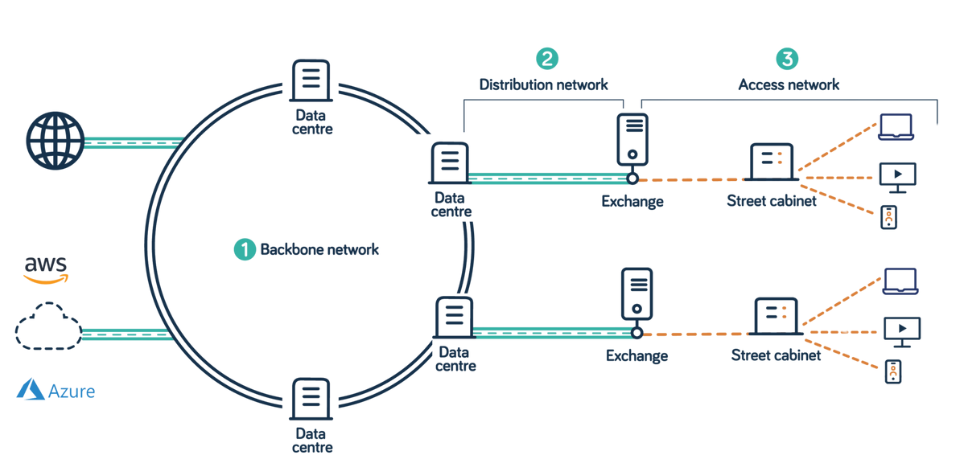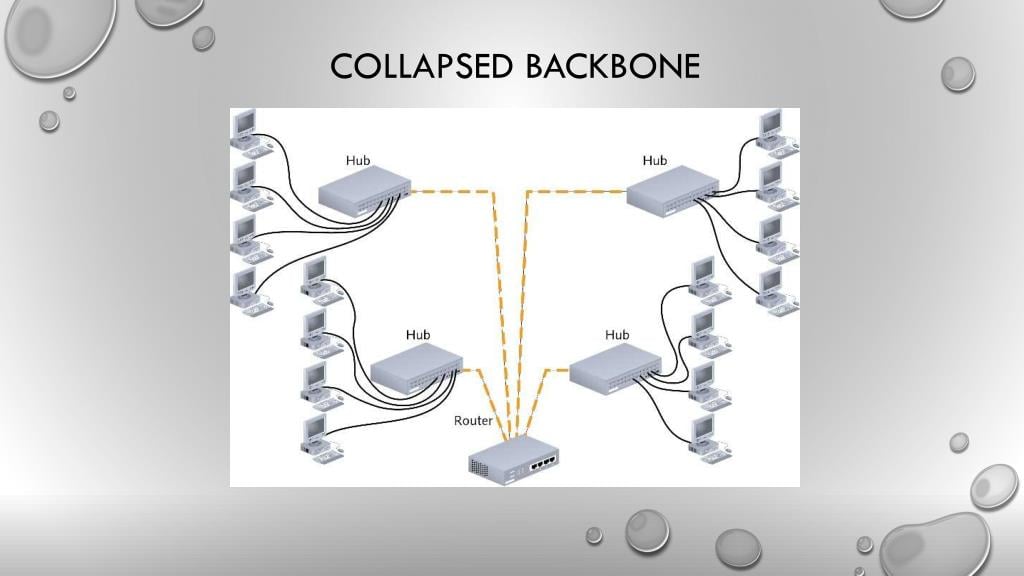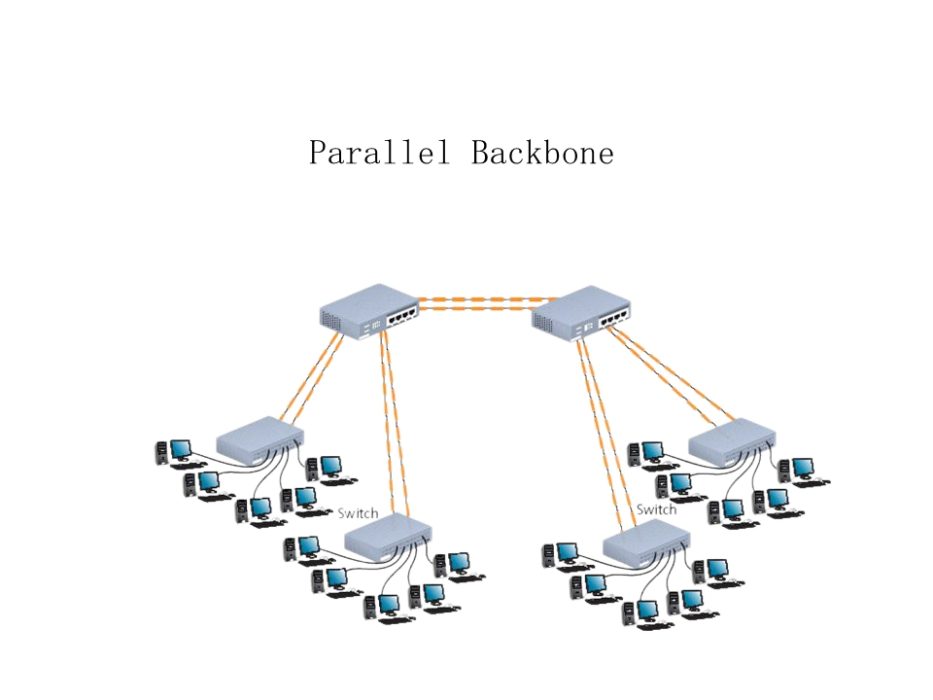Blog, Network Cabling
What Is Backbone Network? The Simple Guide
The digital world has one notable glossary similar to the highway, the artery of road networks, which connects minor pathways to make long-distance travels more convenient and efficient. This article will walk you through the key aspects of the backbone network, including its definition, crucial components, different types, and important functions. Start an exciting journey to uncover the mystery of the backbone network now!
Table of contents
Backbone Network: Definition
A backbone network, also referred to as a core network, is the central infrastructure of large computer networks interconnecting local area networks (LANs), wide area networks (WANs), and subnetworks.
A network of this type, used by data centers and internet service providers (ISPs), allows for high-capacity connectivity between geographically dispersed locations, including large corporations, multi-building campuses, and separate buildings.
Unlike other crucial components of computer networks, such as the distribution network and the access network, the backbone network is equivalent to the core networking highway, ensuring that large networks are reliable and perform well.

Note: A distribution network (perhaps including backhaul), a bridge that links the backbone network to an access network, distributes traffic to streets, buildings, or local area networks.
An access network makes the internet and cloud services accessible, connecting end users to the distribution network directly.
Backbone Network: Critical Components
A backbone network can transmit huge amounts of data efficiently, and it achieves this purpose mainly dependent on routers, switches, fiber cables, and other networking devices, as well as network hubs, network protocols, peering agreements, and network nodes and points of presence (PoPs).
Routers and Switches
They serve as essential devices applied to a backbone network. Routers take charge of directing data packets between various network segments. By working at the network layer (Layer 3) of the OSI (Open Systems Interconnection) model, they choose the optimal route for data according to routing protocols, network policies, and the current conditions of the network paths.
Switches function at the data link layer (Layer 2), responsible for forwarding packets within network segments in line with MAC (Media Access Control) addresses. Layer 3 switches can make routing decisions and perform switching duties, improving the network routing performance in backbone networks.
Peering Agreements
Backbone providers use peering agreements to share network resources and promote data exchange among various networks. In doing so, additional costs will not be incurred. These agreements also enhance routing efficiency, reduce network congestion, and improve network latency. Besides, peering at Internet Exchange Points (IXPs) makes data transfer faster and more direct between backbone networks.
High-Capacity Fiber-Optic Cables
Data transfers in a backbone network via various physical media, including high-capacity fiber-optic cables. They are the physical core of a backbone network because of their high bandwidth and the capacity to transfer vast amounts of data over long distances with minimal signal loss.
Network Hubs
Network hubs lie in the central position, allowing data traffic collected from different channels to flow towards its destination. They are also vital to managing and maintaining data flow in a backbone network.
Network Protocols
There exist many network protocols such as TCP/IP (Transmission Control Protocol/Internet Protocol), and they provide the standard criterion for data packaging, transmission and reception. With the help of these protocols, large amounts of data can achieve a seamless interaction with the backbone network.
Network Nodes and Points of Presence (PoPs)
Network nodes refer to the interconnection points within the backbone network; however, PoPs represent access points that allow network users to link up to the core network. The strategic placement of network nodes and PoPs ensures efficient data routing, lowering network latency, and improving connection reliability.
Backbone Network: Main Types
Backbone networks have various types that satisfy the needs of large corporations, university campuses, and different buildings. Nevertheless, there are four most commonly seen types, which this section will offer you a detailed description.
Distributed Backbone
A collapsed backbone, also called inverted backbone or backbone-in-a-box, is a backbone network architecture centralizing traffic management. It enables a number of connectivity devices to connect back to the central location in a star or a rooted tree topology.

A distributed backbone, usually used for large-scale networks, is a backbone network that comprises quantities of connectivity devices linked up to a variety of central connectivity devices, including routers, hubs, and switches, in a hierarchical order.
All the devices accessing the distributed backbone network share the transmission media because each device can receive data transmissions within the backbone. Besides, a distributed backbone performs its core switching and routing functions across multiple locations or nodes.
A distributed backbone features high scalability across various geographical locations as it permits the addition of new layers of devices without any trouble. This type of backbone network can also reduce network congestion through load distribution.
Collapsed Backbone
The collapsed backbone features a simplified network architecture with fewer network layers. It also uses a single, powerful router as the central connection point to link a multitude of subnetworks. Since the backbone is in a single location, it allows for ease of management.

The collapsed backbone is applied in different places such as data centers, retail chains, and office buildings. In addition to centralized traffic control, it has many advantages. First, hardware costs can be reduced because it requires fewer routers and switches. Second, the collapsed backbone ensures faster data transmission since data does not need to be transferred via multiple routers and switches.
Parallel Backbone
As a variation of a collapsed backbone, a parallel backbone utilizes a connection point and allows for duplicate connections, ensuring network availability, faster speeds, and greater fault tolerance. Backbone network of this kind is a powerhouse that offers the most redundancy and bandwidth. Using multiple cables to connect networking devices, the parallel backbone guarantees the continuity of data flow even though one path fails.

The parallel backbone, whose overall price is much higher than other backbone networks, requires larger amounts of cabling than alternative network topologies. However, it can compensate for the high costs by offering high reliability and more robust performance. Large organizations with high traffic volume and critical corporate requirements should choose it mainly because they want to ensure that the connectivity is never lost.
Serial Backbone
It is the simplest backbone configuration that connects various devices using a single cable in a daisy-chain fashion. Although hubs are often linked to each other in a daisy chain for network extension, they are not the exclusive device for network connections within a serial backbone. A serial backbone also consists of other devices such as routers, switches, gateways, and bridges.

The serial backbone is appropriate for tiny, straightforward networks with minimal devices, just like a group of computers used in a home office. Though it is very simple to deploy, the limited scalability makes the serial backbone unsuitable for growing businesses.
Backbone Network: Functions
As mentioned, the backbone network is critical in providing high-capacity connections between local networks. It also possesses other major functions, including but not limited to:
Aggregation and Redundancy
The backbone network offers the highest level of aggregation within service provider networks. To put it simply, a core network brings data traffic from various sources under centralized control.
In terms of redundancy, a backbone network works with failover mechanisms and backup routes to ensure network reliability reaches its maximum.
Charging
This function is used to collate and handle charging data generated by different network nodes. Modern networks typically have two charging mechanisms: prepaid charging and postpaid charging.
Gateways
Gateways are an essential part of the backbone network, which have the capacity to connect other networks. How gateways function relies on the network types to which they connect.
Routing and Switching
Employing routers and switches, data packets are forwarded far more efficiently across every corner of the backbone network.
Traffic Monitoring
Due to the centrality of a backbone network, users are able to monitor and optimize the data flow. By managing data volume efficiently, the backbone network guarantees Quality of Service (QoS) to prioritize critical traffic types.
Authentication and Security
The backbone network makes use of firewalls, data encryption techniques, and other cybersecurity measures to prevent internet traffic against unauthorized access, data breaches or related cyberattacks.
Conclusion
To sum up, the backbone network plays an essential role in improving network performance, enhancing scalability, and strengthening reliability. A careful reading of this blog will definitely help you discover key components, the exact definition, various types, and the main functions of the backbone network.
Reference







